Product Categories
SHOP BY ARTIST
NEWSLETTER
Ray Lovato
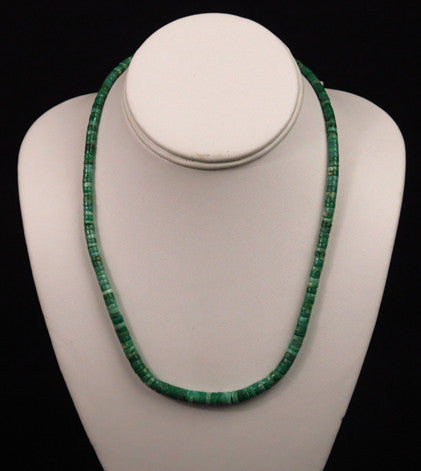
Broken Arrow Variscite Choker by Ray Lovato (#152)
$990.00
Artist: Ray Lovato
18 1/2"
Ray Lovato just drove in with a worn-out Dodge Caravan, six family members, three loaves of freshly baked Pueblo bread and a bag full of treasures. Within that saddle bag was a wonderful choker necklace of Broken Arrow Variscite. Ray said the material came from the Broken Arrow mine in Esmerelda County, Nevada. He met David Otteson, the mine owner, in Santa Fe, New Mexico and bought the rough material. Ray has the magic touch when it comes to turning raw material into a thing of beauty.
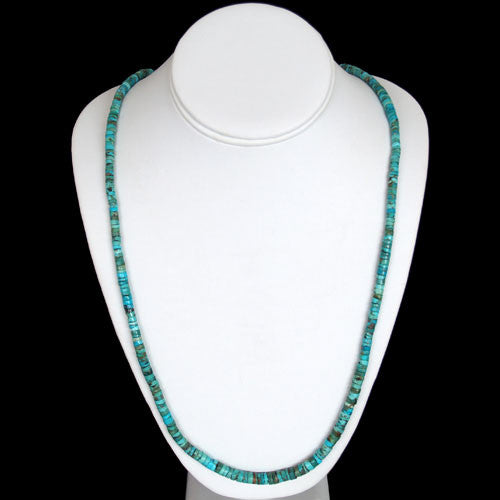
Santo Domingo Handmade Natural Gem Grade Blue Gem Turquoise Bead Necklace - Ray Lovato (#139)
$4,500.00
Artist: Ray Lovato
Total length: 33"
Wrap: 5 1/2"
Blue Gem turquoise jewelry is a rare, valuable and historic American treasure. Quality Blue Gem turquoise is gifted with a wide range of color, all of which are striking, full of wonder and pleasing to the eye. Very few large stones ever came out of the Blue Gem mine. The majority found were small, 1-mm "bleeder" veins and tiny nuggets, which are perfect for Ray Lovato's style of beads. Blue Gem turquoise jewelry was very popular in the late 1930's and 40's because it is extremely durable and very hard, which allows for a high polish and, unlike most turquoise, it doesn't easily change color. Ray and his beads are classic, high quality examples of Native American artistry.
Blue Gem Turquoise
Blue Gem turquoise occurs in argillized quartz monzonite cut by two limonite-stained sheer zones, one trending N 35 o W and dipping 75 o NE, the other trending N, 25 o E and dipping 55 o NW. An extensive breccia zone about 10 feet wide is developed between the two bounding sheers. Exceptionally good quality turquoise forms veins up to three-quarters of an inch thick along the shears. Pyrite-bearing quartz veins are closely associated with the turquoise.
The Blue Gem mine was at one time located deep underground, accessed by tunnels as deep as 800 feet. This is of interest because the Blue Gem Mine and the Bisbee Mine in Arizona are the only two mines (of which we are aware) that turquoise was found that deep in the earth. The Blue Gem mine was once developed in extensive underground workings and open stoops. An audit several hundred feet long on the main structure connected to numerous shorter tunnels and several open stoops. Directly above the main audit was a glory hole some 100 feet long.
Duke Goff first noted the Blue Gem deposit in 1934. It was subsequently leased from the Copper Canyon Mining Co. by the American Gem Co. of San Gabriel, CA., owned by Doc Wilson and his sons, Del and William. The company operated the property until 1941 when the outbreak of the war caused a shortage of experienced miners. Both Del and William Wilson were called into the Army for the duration of the war, and this compelled the closing of the mine. Consequently, the lease was allowed to lapse and work was abandoned. In 1950 Lee Hand and Alvin Layton of Battle Mountain leased the mine.
Production of turquoise at the Blue Gem lease in the early days of the operation was enormous. Although there is no exact information, it is reported that the output amounted to nearly
$1 million in rough turquoise. The mine is still active, although Duval Corp is currently in the center of a major copper deposit developing it.
Pyrite in Blue Gem is unusual to see but not unheard of. Very little large material ever came out of Blue Gem, the majority found was small 1-mm "bleeder" veins and tiny nuggets which was perfect for Zuni inlay and fine needlepoint, petit-point and snake-eyes jewelry. Blue Gem turquoise was very popular in the late 1930's and 40's and was commonly used in the Fred Harvey "tourist jewelry" that is so collectable today. Blue Gem turquoise is extremely hard and stands up well to the test of time.
Blue Gem turquoise is a rare, valuable and historic American treasure. Quality Blue Gem Turquoise has been gifted with a wide range and variety of color. Because Blue Gem turquoise is very hard, a high polish is associated with this stone, and unlike most turquoise, won't easily change color. This turquoise has a unique character and many different looks all of which are striking, full of wonder and pleasing to the eye.
Production of the mine started about 1934 and continued into the 1970's. Blue Gem Turquoise is still some of the finest turquoise ever found, and unlike most turquoise mines, (in which the majority mined is chalky and only usable if stabilized) most of the turquoise found there was of gem-quality. Today the Blue Gem mine is not viable; it sits in the middle of a huge mining operation. The emphasis is on precious metals and the extraction of turquoise is considered more of a hindrance in the mining process rather than an asset. Even the ever-popular "Dump Diving" for turquoise through the overburden is not tolerated due to the very real danger of becoming buried in a slide. Insurance factors, equipment hazards, high explosives and safety issues along with a lack of interest from the mining company keep Blue Gem turquoise unavailable to the world, at least for now.
About the artist:
The gift of humor is a blessing to those who have it, and to those of us exposed to the comic. From an early age, Steve and I have been blessed with the humor of Santa Domingo artist Ray Lovato. Not only does Ray create exceptional jewelry, he does it with wit and comedy. He always has an aura of happiness around him, and this attitude seems to spread, like a California fog, to those who know him. In addition to his artistic talents, Ray is also a gifted salesman. When he pulls up in front of the trading post we know that there is a good possibility that we will soon be parting company with our available cash.
Related legends:
Precious Stones
Turquoise; Precious stones have symbolic implications. For example, turquoise if a "collective term for all the precious stones, wealth, or mixed offerings. Good fortune is attributed to this stone." Both white shell and turquoise are emphasized in Kinaalda? More about this legend
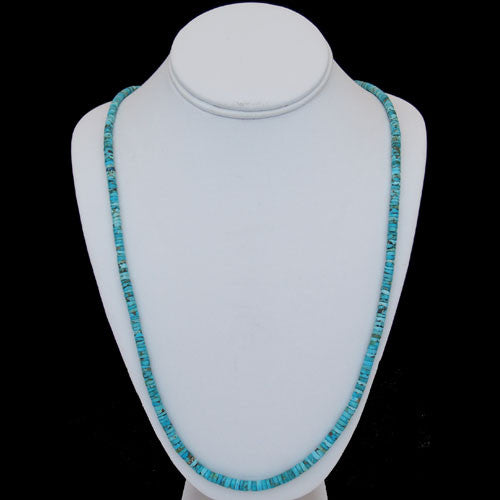
Santo Domingo Handmade Natural Gem Grade Lone Mountain Turquoise Tiny Bead Necklace - Ray Lovato (#142)
$7,500.00
Artist: Ray Lovato
Total Length: 35"
Wrap: 6 1/4"
It has always been our quest to seek out stashes of top grade natural turquoise; whether it’s rough material or individual cabochons with unique color and character. In this case we stumbled upon some small but powerfully potent trimmings from larger stones found and cut from the Lone Mountain turquoise mine near Tonopah, Nevada. The trimmings were perfect for Ray Lovato to re-cut and shape into some of the most exquisite beads we have ever seen from this mine. One never knows where a treasure might be found and what might inspire an artist like Ray.
Lone Mountain
The Lone Mountain turquoise mine is located near Tonapah, in Esmeralda County, Nevada. Since it is known for producing a high percentage of gem-grade turquoise, it is often referred to as a "sweet heart" mine. Originally established in 1920 by Lee Hand, the claim was initially called the Blue Jay Mining Lode. Later, after noting that so many other mines had been named Blue Jay, Hand changed its name to Lone Mountain.
In 1927, at a depth of about 40 feet, Bert Kopenhaver, who had leased the mine from Hand, found the beautiful spider web turquoise that made Lone Mountain one of the top mines in the Southwest. Although it has change hands several times over the years, the mine still produces a small amount of quality material. The Lone Mountain claim is currently owned by Gene Wadell and operated by Chris Lott.
Also known for exquisite, deep blue stones, the mine has historically produced some of the highest quality spider web turquoise in the world. "Fossil turquoise" has also been found in the mine. This was formed when ancient plants and seashells dissolved, leaving only cavities that were later filled with turquoise deposits. Additionally, turquoise nuggets in moss agate have been found. Because of its extraordinary hard nature, Lone Mountain turquoise has the ability to retain its rich color and is therefore a valuable addition to any jewelry collection.
About the artist:

The gift of humor is a blessing to those who have it, and to those of us exposed to the comic. From an early age, Steve and I have been blessed with the humor of Santa Domingo artist Ray Lovato. Not only does Ray create exceptional jewelry, he does it with wit and comedy. He always has an aura of happiness around him, and this attitude seems to spread, like a California fog, to those who know him. In addition to his artistic talents, Ray is also a gifted salesman. When he pulls up in front of the trading post we know that there is a good possibility that we will soon be parting company with our available cash.
Related legends:
Precious Stones
Turquoise; Precious stones have symbolic implications. For example, turquoise if a "collective term for all the precious stones, wealth, or mixed offerings. Good fortune is attributed to this stone." Both white shell and turquoise are emphasized in Kinaalda? More about this legend
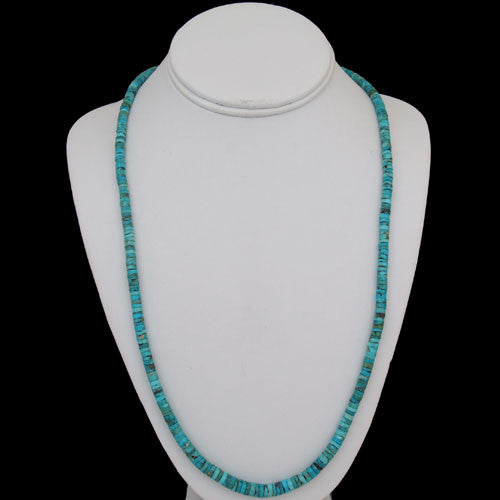
Santo Domingo Handmade Natural Gem Grade McGinnis Nevada Turquoise Necklace - Ray Lovato (#148)
$3,900.00
Artist: Ray Lovato
Length: 35 1/4"
Wrap: 5"
Mother Earth has an innate ability to produce the most visually appealing substances known to man. Such is the case with this subtle but attractive turquoise drawn from the home dirt of the McGinnis mine in central Nevada, USA. Ray Lovato is one of the most prolific Santa Domingo artists currently working with high-grade, natural turquoise. Match Lovato with McGinnis and you have a fabulous string of turquoise beads.
About the artist:

The gift of humor is a blessing to those who have it, and to those of us exposed to the comic. From an early age, Steve and I have been blessed with the humor of Santa Domingo artist Ray Lovato. Not only does Ray create exceptional jewelry, he does it with wit and comedy. He always has an aura of happiness around him, and this attitude seems to spread, like a California fog, to those who know him. In addition to his artistic talents, Ray is also a gifted salesman. When he pulls up in front of the trading post we know that there is a good possibility that we will soon be parting company with our available cash.
Related legends:
Precious Stones
Turquoise; Precious stones have symbolic implications. For example, turquoise if a "collective term for all the precious stones, wealth, or mixed offerings. Good fortune is attributed to this stone." Both white shell and turquoise are emphasized in Kinaalda? More about this legend
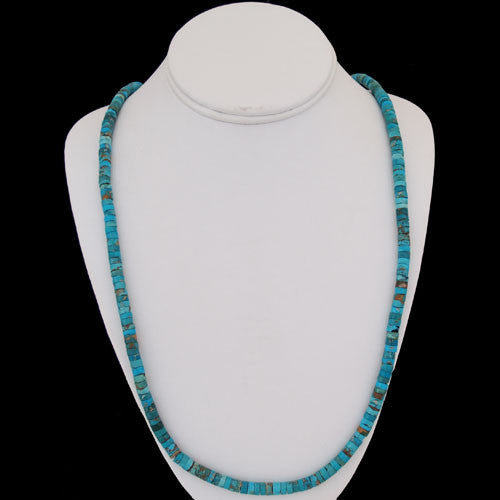
Santo Domingo Handmade Natural Gem Grade Royston Turquoise Bead Necklace - Ray Lovato (#137)
$4,995.00
Artist: Ray Lovato
Length: 38"
Wrap: 7"
Without a doubt, Santa Domingo lapidary artist Ray Lovato is a jokester and trickster. He is a funny guy, but when it comes to creating strands of beautiful beads, Ray is extraordinarily serious. We consider Ray the best of the old style, Native American lapidary artists. He retains the philosophy of maintaining meticulous craftsmanship and using high quality materials. As with this splendid strand of high-grade natural Royston turquoise beads, his attention to detail is distinctly obvious. Whether you are listening to Ray's wisecracks, witnessing his practical jokes or handling a length of his beads, a smile and laugh of delight will certainly come to you. After all, that is what Ray is about.
Royston Turquoise
The Royston Mining District lies on the Nye-Esmerelda County line, about 24 miles northwest of Tonopah, Nevada. In this area, turquoise mines are scattered for nearly a mile along a shallow canyon. Because it involves many small producers, the Royston district is one of the better-known turquoise mining areas in Nevada. Three of the district's more important turquoise mines are the Royal Blue, Bunker Hill and the Oscar Wehrend.
The Royal Blue mine constitutes the main turquoise workings in the district. This turquoise shows as fine-grained, altered porphyry, which is soft in places, although much of it has been hardened by silification. The turquoise is found principally in veinlets and seams, with minor lenses and nodules. The veinlets and lenses range from a fraction of an inch to more than an inch in thickness. Masses of turquoise, filling brecciated matrix, have, however, been found more than five inches thick. Lens shaped pieces of turquoise weighing an ounce or two are not uncommon, and one piece weighing nearly a pound and a half were found.
Royston turquoise ranges in color from dark and pale blue to various shades of green. Some of the dark blue turquoise has a slightly greenish cast, and some is nearly pure blue in color. The dark blue turquoise and that with a greenish cast are very fine grained and hard; the lighter colored ore is generally softer. The best turquoise is often found in limonite stained rock, and the pale blue, softer turquoise is found in light colored, softer porphyry. The quality of the best pure blue stones from the Royal Blue is equal to that found in any American mine and the matrix is especially fine.
The hard turquoise veins and nuggets are coated with a crust or stain of dark to light shading, and at times include a yellow limonite. This stain penetrates the turquoise along seams and branching cracks, producing attractive patterns and contrasts of color. Some large specimens have consisted of a patchwork of dark blue with a slightly greenish tint, marked in places with a very dark red-brown matrix. These cut gems can exhibit exceedingly wide variations of shading, and the matrix contrasts are often striking. Great spider webbing in green or blue nuggets and unusual scenic turquoise pieces are a hallmark of Royston
Two prospectors named Workman and Davis, who later sold the mine to William Petry for $3,000.00, discovered the mine in 1902. Petry improved the mine to the point of assuring its production, and, in 1907, sold it to The Himalaya Mining Co., which was owned by Julius Tannenbaum of Los Angeles and New York. Tannenbaum owned a number of mines in Nevada and California. During 1908 and 1909, the property was systematically and actively worked under the directions of Julius Goldsmith, Tanenbaum's son-in-law. Tannenbaum died suddenly about 1910, and Goldsmith hurried east to settle the estate. Shortly afterwards, he ordered operations abandoned and about 1911 sold the mine back to Petry. Petry and W. I. Miller, who had been Petry's mine boss, operated the mine for a time, and then leased it to Lee Hand and Bert Kopenhaver. Hand and Kopenhaver worked the mine dumps for a time, and then bought the mine outright from Petry. Kopenhaver later sold his share to Charley Bona. Hand and Bona worked the mine periodically, and in 1936 Bona sold his interest to Ted Johnson. In 1940 Johnson sold his share to Lee Hand.
The Otteson family now works the mine. The Otteson story began in 1944 with Lynn Otteson. Lynn brought his family to Nevada to mine turquoise and leased his first Royston claim from Lee Hand. At that time, Hand owned approximately 30 claims in the Royston district. The Otteson family has owned or leased turquoise claims in this district for the past 60 years. The Royal Blue mine has been one of the major turquoise producers in the state of Nevada. For some time, the mine produced as much as 1,250 pounds of turquoise a month, and several times has exceeded that amount.
Petry, at the time he sold the mine to Hand and Kopenhaver, declared that the Royal Blue had produced more gem quality turquoise than any mine in the United States. He placed the value of cut stones taken from the mine at more than $5 million. There is no adequate estimate of the value of gems produced from the mine in the years since that time.
The Bunker Hill is about half a mile north of The Royal Blue. In this mine, turquoise occurs in altered quartzite and ranges from royal blue to greenish blue with brown with white matrix. Turquoise is mainly in the form of slabs from 1/16 of an inch to a full inch thick. The mine was discovered in 1927 by Roy Palfreyman and Bert Kopenhaver, and was originally opened as a small shaft about 20 feet deep. As the turquoise was unearthed, the shaft was widened along the seam into a long stope, which was eventually opened into a glory hole. Polfreyman and Kopenhaver took out about $30,000 worth of turquoise, then sold to the owners of the Royal Blue mine, who produced about $75,000 worth of material. The mine eventually was incorporated into the Royal Blue group of claims.
The Oscar Wehrend mine, in the Royston district, is about 1/3 of a mile from the main workings of the Royal Blue. The turquoise is in highly altered rocks, where it forms seams, coatings and nodules as large as 2 inches thick. It is mostly soft, pale, and not of very good quality. Its color and hardness can, however, be improved by artificial means. Oscar Wehrend discovered the deposit in 1909, but Lee Hand conducted much of the work. Production from the property has been small.
The Royston Mine was originally worked as a silver mine in the late 1800s, Large deposits of high quality turquoise led Tiffany's of New York to incorporate quality green and blue turquoise stones from the Royston Hills into their jewelry lines prior to WWII. There was a brief surge of Royston turquoise production in the 1970s, and the Royston district is still producing limited amounts of high quality turquoise. The turquoise currently being produced from the Royston district is mined by Dean and Danny Otteson, and is coming from the Royal Royston claim.
About the artist:
The gift of humor is a blessing to those who have it, and to those of us exposed to the comic. From an early age, Steve and I have been blessed with the humor of Santa Domingo artist Ray Lovato. Not only does Ray create exceptional jewelry, he does it with wit and comedy. He always has an aura of happiness around him, and this attitude seems to spread, like a California fog, to those who know him. In addition to his artistic talents, Ray is also a gifted salesman. When he pulls up in front of the trading post we know that there is a good possibility that we will soon be parting company with our available cash.
See full biography
Related legends:
Precious Stones
Turquoise; Precious stones have symbolic implications. For example, turquoise if a "collective term for all the precious stones, wealth, or mixed offerings. Good fortune is attributed to this stone." Both white shell and turquoise are emphasized in Kinaalda? More about this legend
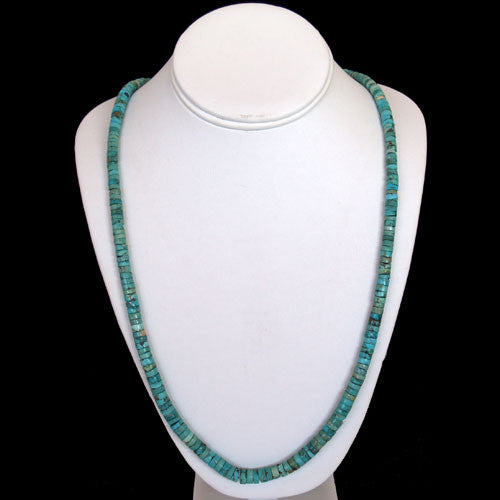
Santo Domingo Handmade Natural Gem Grade Royston Turquoise Bead Necklace - Ray Lovato (#140)
$4,500.00
Artist: Ray Lovato
Total length: 33 1/2"
Wrap: 4"
Ray Lovato is surely one of the characters of Twin Rocks Trading Post. As Barry and I will absolutely affirm, Ray never leaves the trading post without making an impression. Whether it is his off-color jokes or his on-color turquoise, we are always happier having seen him. This week he brought humor and a great strand of Royston turquoise beads to make us smile. We feel we can never have too many sets of his beads, since we wonder how long he can continue to produce.
Royston Turquoise
The Royston Mining District lies on the Nye-Esmerelda County line, about 24 miles northwest of Tonopah, Nevada. In this area, turquoise mines are scattered for nearly a mile along a shallow canyon. Because it involves many small producers, the Royston district is one of the better-known turquoise mining areas in Nevada. Three of the district's more important turquoise mines are the Royal Blue, Bunker Hill and the Oscar Wehrend.
The Royal Blue mine constitutes the main turquoise workings in the district. This turquoise shows as fine-grained, altered porphyry, which is soft in places, although much of it has been hardened by silification. The turquoise is found principally in veinlets and seams, with minor lenses and nodules. The veinlets and lenses range from a fraction of an inch to more than an inch in thickness. Masses of turquoise, filling brecciated matrix, have, however, been found more than five inches thick. Lens shaped pieces of turquoise weighing an ounce or two are not uncommon, and one piece weighing nearly a pound and a half were found.
Royston turquoise ranges in color from dark and pale blue to various shades of green. Some of the dark blue turquoise has a slightly greenish cast, and some is nearly pure blue in color. The dark blue turquoise and that with a greenish cast are very fine grained and hard; the lighter colored ore is generally softer. The best turquoise is often found in limonite stained rock, and the pale blue, softer turquoise is found in light colored, softer porphyry. The quality of the best pure blue stones from the Royal Blue is equal to that found in any American mine and the matrix is especially fine.
The hard turquoise veins and nuggets are coated with a crust or stain of dark to light shading, and at times include a yellow limonite. This stain penetrates the turquoise along seams and branching cracks, producing attractive patterns and contrasts of color. Some large specimens have consisted of a patchwork of dark blue with a slightly greenish tint, marked in places with a very dark red-brown matrix. These cut gems can exhibit exceedingly wide variations of shading, and the matrix contrasts are often striking. Great spider webbing in green or blue nuggets and unusual scenic turquoise pieces are a hallmark of Royston
Two prospectors named Workman and Davis, who later sold the mine to William Petry for $3,000.00, discovered the mine in 1902. Petry improved the mine to the point of assuring its production, and, in 1907, sold it to The Himalaya Mining Co., which was owned by Julius Tannenbaum of Los Angeles and New York. Tannenbaum owned a number of mines in Nevada and California. During 1908 and 1909, the property was systematically and actively worked under the directions of Julius Goldsmith, Tanenbaum's son-in-law. Tannenbaum died suddenly about 1910, and Goldsmith hurried east to settle the estate. Shortly afterwards, he ordered operations abandoned and about 1911 sold the mine back to Petry. Petry and W. I. Miller, who had been Petry's mine boss, operated the mine for a time, and then leased it to Lee Hand and Bert Kopenhaver. Hand and Kopenhaver worked the mine dumps for a time, and then bought the mine outright from Petry. Kopenhaver later sold his share to Charley Bona. Hand and Bona worked the mine periodically, and in 1936 Bona sold his interest to Ted Johnson. In 1940 Johnson sold his share to Lee Hand.
The Otteson family now works the mine. The Otteson story began in 1944 with Lynn Otteson. Lynn brought his family to Nevada to mine turquoise and leased his first Royston claim from Lee Hand. At that time, Hand owned approximately 30 claims in the Royston district. The Otteson family has owned or leased turquoise claims in this district for the past 60 years. The Royal Blue mine has been one of the major turquoise producers in the state of Nevada. For some time, the mine produced as much as 1,250 pounds of turquoise a month, and several times has exceeded that amount.
Petry, at the time he sold the mine to Hand and Kopenhaver, declared that the Royal Blue had produced more gem quality turquoise than any mine in the United States. He placed the value of cut stones taken from the mine at more than $5 million. There is no adequate estimate of the value of gems produced from the mine in the years since that time.
The Bunker Hill is about half a mile north of The Royal Blue. In this mine, turquoise occurs in altered quartzite and ranges from royal blue to greenish blue with brown with white matrix. Turquoise is mainly in the form of slabs from 1/16 of an inch to a full inch thick. The mine was discovered in 1927 by Roy Palfreyman and Bert Kopenhaver, and was originally opened as a small shaft about 20 feet deep. As the turquoise was unearthed, the shaft was widened along the seam into a long stope, which was eventually opened into a glory hole. Polfreyman and Kopenhaver took out about $30,000 worth of turquoise, then sold to the owners of the Royal Blue mine, who produced about $75,000 worth of material. The mine eventually was incorporated into the Royal Blue group of claims.
The Oscar Wehrend mine, in the Royston district, is about 1/3 of a mile from the main workings of the Royal Blue. The turquoise is in highly altered rocks, where it forms seams, coatings and nodules as large as 2 inches thick. It is mostly soft, pale, and not of very good quality. Its color and hardness can, however, be improved by artificial means. Oscar Wehrend discovered the deposit in 1909, but Lee Hand conducted much of the work. Production from the property has been small.
The Royston Mine was originally worked as a silver mine in the late 1800s, Large deposits of high quality turquoise led Tiffany's of New York to incorporate quality green and blue turquoise stones from the Royston Hills into their jewelry lines prior to WWII. There was a brief surge of Royston turquoise production in the 1970s, and the Royston district is still producing limited amounts of high quality turquoise. The turquoise currently being produced from the Royston district is mined by Dean and Danny Otteson, and is coming from the Royal Royston claim.
About the artist:
The gift of humor is a blessing to those who have it, and to those of us exposed to the comic. From an early age, Steve and I have been blessed with the humor of Santa Domingo artist Ray Lovato. Not only does Ray create exceptional jewelry, he does it with wit and comedy. He always has an aura of happiness around him, and this attitude seems to spread, like a California fog, to those who know him. In addition to his artistic talents, Ray is also a gifted salesman. When he pulls up in front of the trading post we know that there is a good possibility that we will soon be parting company with our available cash.
Related legends:
Precious Stones
Turquoise; Precious stones have symbolic implications. For example, turquoise if a "collective term for all the precious stones, wealth, or mixed offerings. Good fortune is attributed to this stone." Both white shell and turquoise are emphasized in Kinaalda? More about this legend
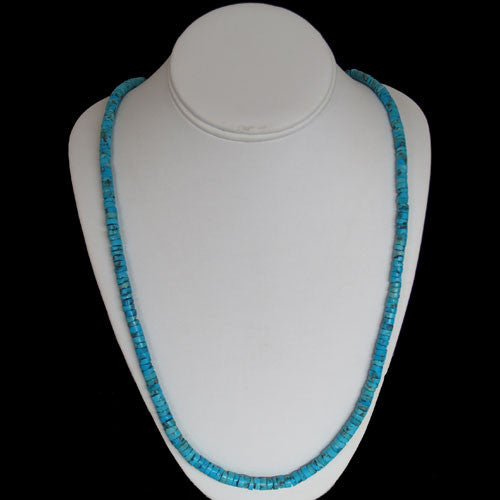
Santo Domingo Handmade Natural Gem Grade Sleeping Beauty Turquoise Bead Necklace - Ray Lovato (#138)
$3,950.00
Artist: Ray Lovato
Length: 37"
Wrap: 5"
Sleeping Beauty Turquoise
The Sleeping Beauty turquoise mine is located seven miles from Globe, Arizona. The mine is one of the largest producers of turquoise in North America. The mine, and the turquoise extracted from it, derives its name from Sleeping Beauty Mountain, which at one time was part of the Copper Cities operation. The center of the copper mine is located at approximately 33o24"13.23"N. 110o53'34. 60"W, at an elevation of 1224 feet. Sleeping Beauty Turquoise Mining is presently owned and operated by Monty Nichols.
For many centuries before the first Europeans made their way into Arizona, turquoise was being mined on the slopes of Sleeping Beauty Mountain. The Salado and other ancient peoples mined the beautiful sky stone from several surface outcroppings located in the vicinity, including Pinto Valley. It is believed that Spanish explorers were the first Europeans to locate the source of Sleeping Beauty sometime around the 1860s. By the 1870s, small underground mines pockmarked the hills surrounding present day Globe.
Cities Service Company started the Copper Cities Mine (commonly called the Sleeping Beauty Mine) in 1952 and operated it until the Pinto Valley mine opened in 1972. During the 1960s, L.W. Hardy had the contract to mine turquoise, both at Sleeping Beauty and at Castle Dome, later called the Pinto Valley Mine. Formerly a meat cutter at a market in Miami, Hardy recognized early on that turquoise was more valuable as a gemstone than the associated copper.
By the time the turquoise boom began, Hardy had contracts with mining companies in Miami, Kingman and elsewhere. He also developed a method for stabilizing low-grade, porous turquoise with pressure-impregnated hot acrylic resin, which hardened the stone and improved the color.
Hardy's mining methods were primitive when compared with current operations. Hardy's workers sat in a ditch ripped by a bulldozer and hand picked the stone from waste-rock. Hardy mined turquoise at Sleeping Beauty for 22 years, getting about 45 percent recovery, and leaving the rest in waste dumps.
Monty Nichols received the contract to mine Sleeping Beauty turquoise in 1988, and began using modern mining methods to develop the property. Nichols drills and blasts the overburden, hauling it to the abandoned Copper Cities pit, which now contains the recycled tailings from Miami Copper Company's No. 5 tailing dam. The old dam dominated the eastern skyline of downtown Miami until recently. The year Nichols acquired the contract; he began a two-year project to remove 5,000.000 tons of overburden. Located half way up the side of an open pit mine, the narrow turquoise-bearing zone has about 400 feet of hard waste rock on top of it. In order to move sideways into the ore-body, a whole slice of the mountain had to be removed.
To avoid fracturing the turquoise, Nichols was careful not to blast too near the turquoise-bearing strata. That layer is more crumbly, so the miners can rip it and dump it over screens, separating the material by size. No crushers are used, again to avoid fracturing the gemstone, and the different sized rock is hauled up to a wide mine bench where conveyor belts move the material through three buildings. There, workers handpick turquoise from the broken rock. The buildings are vented with filtered air to eliminate workers' exposure to dust, and well insulated to keep them comfortable in any weather. It is a far cry from the old methods of mining. Anywhere from 30 to 40 people work at the mine at any one time, depending on how much mining there is to do.
Fifty years ago, mine workers filled lunch buckets with the colorful rock, even though it was reason for immediate termination. Old habits die hard, and some people still think it is okay to sneak in and try to pick turquoise. As a result, security is tight in and around the mine. Motion detectors, night vision cameras and 24/7 roving patrols are used, so the only turquoise leaving the property now is being shipped to markets around the world.
Italy is the largest volume buyer of Sleeping Beauty turquoise, with Germany and Hong Kong following closely behind. These customers buy the best grade for their exclusive jewelry. Jewelry makers in India and Spain also receive Sleeping Beauty turquoise, while in the U.S., Gallup and Albuquerque are the largest consumers.
The Sleeping Beauty turquoise mine produces a uniform light to medium blue turquoise with rare finds of deep, dark blue. Because of its uniformity, it has been a favorite of the Zuni Pueblo. Zuni silversmiths often use it in channel inlay and various types of cluster work that require large numbers of small, perfectly matched stones. The Sleeping Beauty mine has been one of the larger producers of rough turquoise in the United States, although today much less good turquoise is being produced than in the past.
Sleeping Beauty turquoise is noted for its solid, light blue color with no matrix; the host rock is usually granite. Nichols says the mine is producing about 1,600 pounds a month. Of that, only four percent is natural; most of the turquoise from the mine is altered in some way. Most is enhanced, which is more expensive than stabilization, and sold to large distributors in this country and Europe. Currently most of the turquoise that comes from the mine is from the tons of tailings piles that have been accumulating for decades.
The best of the Sleeping Beauty turquoise is comparable to that found in the Middle East. It is thought that large quantities of Sleeping Beauty turquoise is taken overseas and smuggled into, then out of, Iran to be sold as “Persian” turquoise.
About the artist:

The gift of humor is a blessing to those who have it, and to those of us exposed to the comic. From an early age, Steve and I have been blessed with the humor of Santa Domingo artist Ray Lovato. Not only does Ray create exceptional jewelry, he does it with wit and comedy. He always has an aura of happiness around him, and this attitude seems to spread, like a California fog, to those who know him. In addition to his artistic talents, Ray is also a gifted salesman. When he pulls up in front of the trading post we know that there is a good possibility that we will soon be parting company with our available cash.
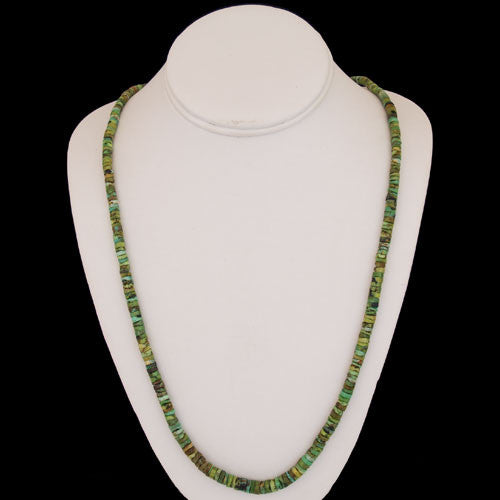
Santo Domingo Handmade Natural Gem Grade Stennich Turquoise Bead Necklace - Ray Lovato (#147)
$6,500.00
Artist: Ray Lovato
31" long
Wrap: 4 3/4"
Stennich Turquoise
August “Gus” Stenich was an elderly Austrian emigrant who owned a gold mine along with several significant turquoise claims, including his namesake, Stenich. Gus quickly developed a reputation as an ornery and suspicious character, figuring this type of reputation would help protect his claims from the many turquoise scavengers and cheats who would steal turquoise and gold from his claims when he was in town buying supplies. The Stenich mine and all of Gus’s claims were willed to J.W. Edgar upon Stenich’s death. It is said that his last will and its details were written out on an old bread wrapper paper that was found with Gus’s body at his Stenich campsite.
About the artist:

The gift of humor is a blessing to those who have it, and to those of us exposed to the comic. From an early age, Steve and I have been blessed with the humor of Santa Domingo artist Ray Lovato. Not only does Ray create exceptional jewelry, he does it with wit and comedy. He always has an aura of happiness around him, and this attitude seems to spread, like a California fog, to those who know him. In addition to his artistic talents, Ray is also a gifted salesman. When he pulls up in front of the trading post we know that there is a good possibility that we will soon be parting company with our available cash.
Related legends:
Precious Stones
Turquoise; Precious stones have symbolic implications. For example, turquoise if a "collective term for all the precious stones, wealth, or mixed offerings. Good fortune is attributed to this stone." Both white shell and turquoise are emphasized in Kinaalda? More about this legend
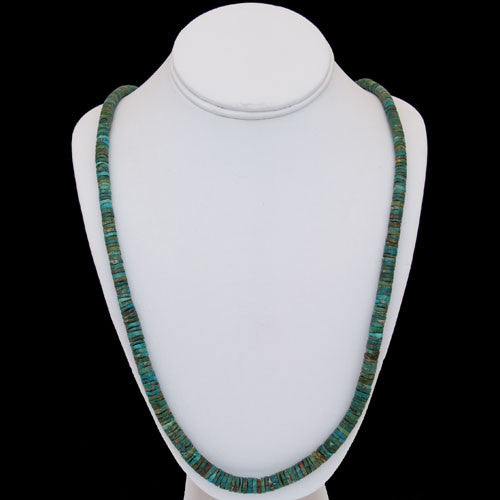
Santo Domingo Handmade Natural Gem Grade Stone Mountain Turquoise Bead Necklace - Ray Lovato (#143)
$8,500.00
Artist: Ray Lovato
Length: 35"
Wrap: 6 1/4"
Stone Mountain turquoise is not extremely well known. Not yet anyway. It is a mine that has not produced large quantities of turquoise. The top end is however, very beautiful. With much straining of the eyes and finger picking through the rough material, we have sorted a selection of high-grade green material. When we showed the selection of stones to Ray Lovato, his desire to work it was off the charts. Ray created this most stunning necklace that will certainly cause connoisseurs of natural turquoise to reconsider their opinions. There is top grade turquoise in every mine, and this is some of the very best from Stone Mountain.
Stone Mountain Turquoise
Stone Mountain Mine is located in high deserts of Lyon County, Nevada. The mine was discovered in the late 1970's. The majority of the turquoise recovered from this mine is recovered by pick and shovel.
About the artist:

The gift of humor is a blessing to those who have it, and to those of us exposed to the comic. From an early age, Steve and I have been blessed with the humor of Santa Domingo artist Ray Lovato. Not only does Ray create exceptional jewelry, he does it with wit and comedy. He always has an aura of happiness around him, and this attitude seems to spread, like a California fog, to those who know him. In addition to his artistic talents, Ray is also a gifted salesman. When he pulls up in front of the trading post we know that there is a good possibility that we will soon be parting company with our available cash.
Related legends:
Precious Stones
Turquoise; Precious stones have symbolic implications. For example, turquoise if a "collective term for all the precious stones, wealth, or mixed offerings. Good fortune is attributed to this stone." Both white shell and turquoise are emphasized in Kinaalda? More about this legend
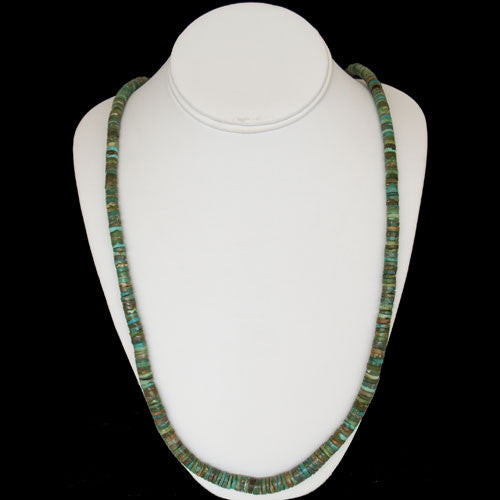
Santo Domingo Handmade Natural Gem Grade Stone Mountain Turquoise Necklace - Ray Lovato (#136)
$6,500.00
Artist: Ray Lovato
Length: 35 1/2"
Wrap: 6"
Handmade turquoise beads, those are Ray Lavato’s specialty. Ray makes them in the old style, and his necklaces are always, and I mean always, beautiful. One of the nicest things about them is that they get prettier the more you wear them. After a time, the turquoise takes on a personality of its own and, like its wearer, becomes distinctive. This natural Stone Mountain turquoise necklace will make you happy for a very long time, and then be ready for the next generation of wearers.
Stone Mountain Turquoise
Stone Mountain Mine is located in high deserts of Lyon County, Nevada. The mine was discovered in the late 1970's. The majority of the turquoise recovered from this mine is recovered by pick and shovel.
About the artist:

The gift of humor is a blessing to those who have it, and to those of us exposed to the comic. From an early age, Steve and I have been blessed with the humor of Santa Domingo artist Ray Lovato. Not only does Ray create exceptional jewelry, he does it with wit and comedy. He always has an aura of happiness around him, and this attitude seems to spread, like a California fog, to those who know him. In addition to his artistic talents, Ray is also a gifted salesman. When he pulls up in front of the trading post we know that there is a good possibility that we will soon be parting company with our available cash.
Related legends:
Precious Stones
Turquoise; Precious stones have symbolic implications. For example, turquoise if a "collective term for all the precious stones, wealth, or mixed offerings. Good fortune is attributed to this stone." Both white shell and turquoise are emphasized in Kinaalda? More about this legend
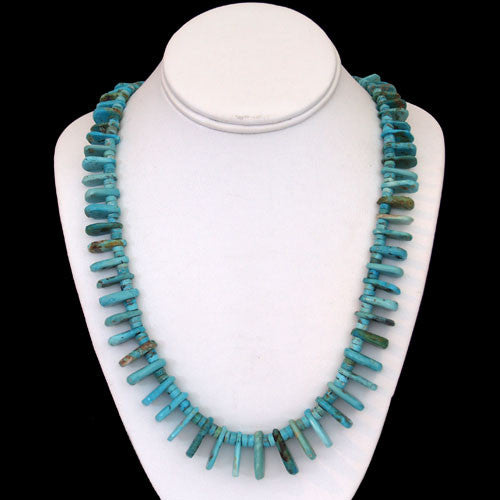
Santo Domingo Handmade Natural Gem Grade White-horse Nevada Turquoise Tab Necklace - Ray Lovato (#144)
$1,250.00
Artist: Ray Lovato
Length: 30"
Largest tab: .43" x .87"
Ray Lovato is to tab turquoise necklaces what Barry and Steve are to Twin Rocks, inseparable. I know that is a shameless comparison, but I can’t help it. We can’t get out of the post and Ray cannot stop making beads. So there we are! This tab necklace features the best of Ray’s work. Made with Whitehorse turquoise from Nevada, it is appropriate for traditional or contemporary celebrations.
Fox Turquoise
Fox turquoise jewelry has been a part of fine Native American turquoise jewelry for decades. The Fox mine has probably produced more turquoise than all the other mines in the state put together; a conservative estimate of the total production has been put "not less than 500,000 pounds." For years the mine produced more than 2,000 pounds of turquoise a month. The bulk of Fox turquoise is only a fair quality, being deficient in color, but is quite hard and excellently suited to artificial coloring. For this purpose, most of the mine production for years was sold to factories in Idar-Oberstein, Germany. Much excellent ore was, however, processed in the United States.
The Fox turquoise mine is in a faulted, argillized block of chert in which the beds strike predominantly N. 60-degrees E. and dip about 45 degrees SE. Pseudomorphs of limonite after pyrite attest to the former presence of pyrite in the argillized zone. Greenish and blue turquoise occur in silicified, limonite veinlets that follow the bedding. Smaller veinlets form flat-lying units in the chert.
George Schmidtlein visited the deposit about 1910 or 1912; the location of the Fox mine was revealed to Schmidtlein by a servant in his household. The Indians had known it for centuries and almost everyone in the vicinity had some of the turquoise in one form or another. In 1912 Schmidtlein and his wife made a trip east, taking some of the turquoise to the C. D. Peacock Jewelry Co., in Chicago. Peacock agreed that Fox turquoise was "very pretty," but knew of no market for it, so Schmidtlein dropped the matter.
In 1914, Charles Schmidtlein, son of George, and Johnnie Francis filed an official notice of location on the property under the name of "Fox Lode Mining Claim." Other mines had been developed in Nevada at the time, and a definite market for the ore had been established. Schmidtlein and Francis worked the claim until they had established its value and, in 1915 sold the property to William R. McGaw for $3000.00.
McGaw put a crew of miners to work extending the development. The Fox turquoise mine has been developed as an open cut. Another cut was opened along the face of the vein and production expanded. Following the death of McGaw, Edward C. Smith, a relative, assumed management of the mine. When Smith died, his son Charles E. Smith became manager.
In the 1940's, Dowell Ward purchased the old Cortez claims and developed them using the names Fox, White Horse, Green Tree and Smith to differentiate among the colors produced in the area and to create a larger perceived share of the turquoise market. The area produces a huge amount of good quality green or blue-green turquoise with a distinctive matrix. The story is told that during the time he owned the claims, Dowell Ward, amassed one of the largest collections of rough turquoise ever. Dowell's widow Faye is now in possession of the collection and the claims.
The turquoise was found in nodules of all sizes; hundreds were as large as a man’s fist, many even larger. The Fox mine is also known for the sea foam type of nuggets and blue green kind of bubbly material it produces. It is often left in its "nugget" rough state and slightly polished for that appearance. The mine is being worked again and this is new material. The color ranges from blue/green to a dark blue. The material is solid and hard (for turquoise) and cuts well. The rough is almost all nuggets.
The largest true-blue nugget without matrix inclusions found at the Fox turquoise mine weighed slightly more than one pound, (a troy weight pound is about 1,866 carats) and was presented to the Smithsonian Institution in Washington, D.C. Another huge nugget, almost as large, was presented to Tiffany & Co., New York City. Mrs. Clara L. McGaw had a nugget, which weighed about one pound but this had a slight amount of matrix in it.
Fox Mine; Nevada, Lander County, Bullion District. The Cortez or Fox turquoise mine is in the bottom of a canyon in the NE1/4, sec. 34, T. 27N, R. 47 E. about 1.5 miles southwest from the mouth of Cortez Canyon. The mine is accessible over a well-graded road.
About the artist:
The gift of humor is a blessing to those who have it, and to those of us exposed to the comic. From an early age, Steve and I have been blessed with the humor of Santa Domingo artist Ray Lovato. Not only does Ray create exceptional jewelry, he does it with wit and comedy. He always has an aura of happiness around him, and this attitude seems to spread, like a California fog, to those who know him. In addition to his artistic talents, Ray is also a gifted salesman. When he pulls up in front of the trading post we know that there is a good possibility that we will soon be parting company with our available cash.
Related legends:
Precious Stones
Turquoise; Precious stones have symbolic implications. For example, turquoise if a "collective term for all the precious stones, wealth, or mixed offerings. Good fortune is attributed to this stone." Both white shell and turquoise are emphasized in Kinaalda? More about this legend
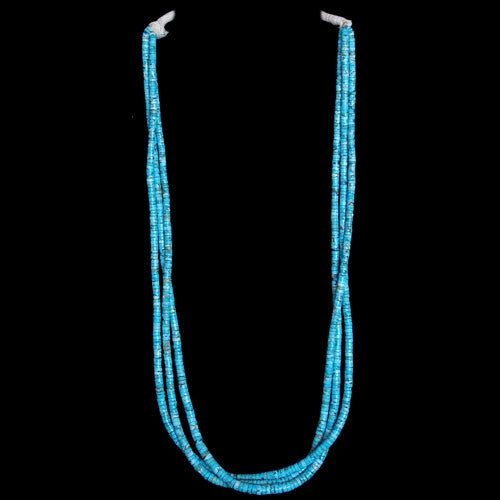
Santo Domingo Lone Mountain Turquoise 3 Strand Necklace - Ray Lovato (#110)
$16,500.00
Artist: Ray Lovato
Southwest Jewelry
35"
This magnificent three strand bead necklace was created by master lapidary artist Ray Lovato, and is cut from high-grade, natural, sky blue Lone Mountain turquoise. Lone Mountain is a hard, durable turquoise that has always been noted for holding its color. Among all “classic” Southwestern turquoise, only Lander Blue is considered more valuable. The Lone Mountain mine consists of a series of haphazard tunnels dug by miners chasing valuable veins. The mine was claimed by Lee Hand in 1920, first as the Blue Jay Mining Lode and later as Lone Mountain. In the 1960s, Lone Mountain was converted to a small open pit operations by Menliss Winfield, and to this day continues to be mined in that fashion. In 1979 Gene Waddell purchased the claim with the King family of Austin, Texas and Santa Fe, New Mexico. Gene has had several partners over the years, but the property has only been mined six of the last 28 years. Ray discovered this turquoise in a private collection and talked the owner into letting him purchase the stash. This necklace is a turquoise treasure if ever there was one.
We offer a 100% satisfaction guarantee on every purchase.
Lone Mountain Turquoise
The Lone Mountain turquoise mine is located near Tonapah, in Esmeralda County, Nevada. Since it is known for producing a high percentage of gem-grade turquoise, it is often referred to as a "sweet heart" mine. Originally established in 1920 by Lee Hand, the claim was initially called the Blue Jay Mining Lode. Later, after noting that so many other mines had been named Blue Jay, Hand changed its name to Lone Mountain.
In 1927, at a depth of about 40 feet, Bert Kopenhaver, who had leased the mine from Hand, found the beautiful spiderweb turquoise that made Lone Mountain one of the top mines in the Southwest. Although it has change hands several times over the years, the mine still produces a small amount of quality material. The Lone Mountain claim is currently owned by Gene Wadell and operated by Chris Lott.
Also known for exquisite, deep blue stones, the mine has historically produced some of the highest quality spiderweb turquoise in the world. "Fossil turquoise" has also been found in the mine. This was formed when ancient plants and sea shells dissolved, leaving only cavities that were later filled with turquoise deposits. Additionally, turquoise nuggets in moss agate have been found. Because of its extraordinary hard nature, Lone Mountain turquoise has the ability to retain its rich color and is therefore a valuable addition to any jewelry collection.
About the artist:

The gift of humor is a blessing to those who have it, and to those of us exposed to the comic. From an early age, Steve and I have been blessed with the humor of Santa Domingo artist Ray Lovato. Not only does Ray create exceptional jewelry, he does it with wit and comedy. He always has an aura of happiness around him, and this attitude seems to spread, like a California fog, to those who know him. In addition to his artistic talents, Ray is also a gifted salesman. When he pulls up in front of the trading post we know that there is a good possibility that we will soon be parting company with our available cash.
Related legends:
Precious Stones
Turquoise; Precious stones have symbolic implications. For example, turquoise if a "collective term for all the precious stones, wealth, or mixed offerings. Good fortune is attributed to this stone." Both white shell and turquoise are emphasized in Kinaalda? More about this legend
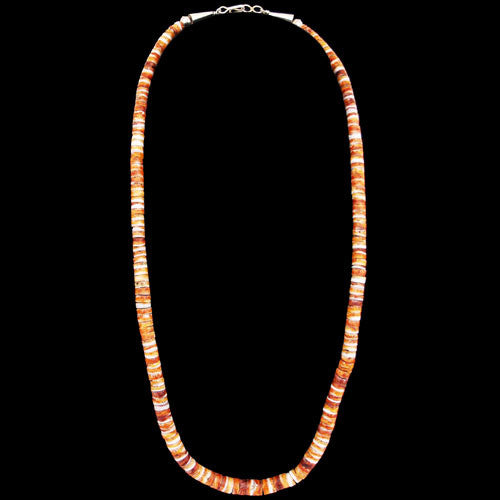
Santo Domingo Orange Spiny Oyster Necklace - Ray Lovato (#127)
$600.00
Artist: Ray Lovato
Southwest Jewelry
20 1/2" long
For a glimpse of good, old-fashioned bead craft one only need look to Ray Lovato. This master Santa Domingo artist retains and reflects the lessons learned from his ancestors to create modern marvels. Using Spondylus shells gathered from the Gulf of Mexico, Ray hand grinds each bead individually to achieve such serpentine creations. For an artist with a grip on the past and an eye on the future we simply look to Ray.
We offer a 100% satisfaction guarantee on every purchase.
About the artist:

The gift of humor is a blessing to those who have it, and to those of us exposed to the comic. From an early age, Steve and I have been blessed with the humor of Santa Domingo artist Ray Lovato. Not only does Ray create exceptional jewelry, he does it with wit and comedy. He always has an aura of happiness around him, and this attitude seems to spread, like a California fog, to those who know him. In addition to his artistic talents, Ray is also a gifted salesman. When he pulls up in front of the trading post we know that there is a good possibility that we will soon be parting company with our available cash.
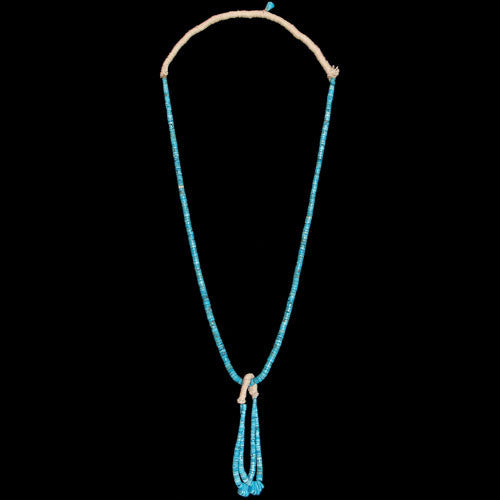
Santo Domingo Sleeping Beauty Turquoise Necklace w/ Jacla - Ray Lovato (#120)
$3,900.00
Artist: Ray Lovato
Southwest Jewelry
33" long
Natural Sleeping Beauty turquoise is the basis for this Ray and Melissa Lovato Santo Domingo bead necklace. Ray, and his daughter Melissa, are known far and wide for their work. Many argue Ray’s necklaces are the best contemporary examples of old style Santo Domingo beads available. We agree, and collect them whenever we can. You might want to do the same.
We offer a 100% satisfaction guarantee on every purchase.
Sleeping Beauty Turquoise
The Sleeping Beauty turquoise mine is located seven miles from Globe, Arizona. The mine is one of the largest producers of turquoise in North America. The mine, and the turquoise extracted from it, derives its name from Sleeping Beauty Mountain, which at one time was part of the Copper Cities operation. The center of the copper mine is located at approximately 33o24"13.23"N. 110o53'34. 60"W, at an elevation of 1224 feet. Sleeping Beauty Turquoise Mining is presently owned and operated by Monty Nichols.
For many centuries before the first Europeans made their way into Arizona, turquoise was being mined on the slopes of Sleeping Beauty Mountain. The Salado and other ancient peoples mined the beautiful sky stone from several surface outcroppings located in the vicinity, including Pinto Valley. It is believed that Spanish explorers were the first Europeans to locate the source of Sleeping Beauty sometime around the 1860s. By the 1870s, small underground mines pockmarked the hills surrounding present day Globe.
Cities Service Company started the Copper Cities Mine (commonly called the Sleeping Beauty Mine) in 1952 and operated it until the Pinto Valley mine opened in 1972. During the 1960s, L.W. Hardy had the contract to mine turquoise, both at Sleeping Beauty and at Castle Dome, later called the Pinto Valley Mine. Formerly a meat cutter at a market in Miami, Hardy recognized early on that turquoise was more valuable as a gemstone than the associated copper.
By the time the turquoise boom began, Hardy had contracts with mining companies in Miami, Kingman and elsewhere. He also developed a method for stabilizing low-grade, porous turquoise with pressure-impregnated hot acrylic resin, which hardened the stone and improved the color.
Hardy's mining methods were primitive when compared with current operations. Hardy's workers sat in a ditch ripped by a bulldozer and hand picked the stone from waste-rock. Hardy mined turquoise at Sleeping Beauty for 22 years, getting about 45 percent recovery, and leaving the rest in waste dumps.
Monty Nichols received the contract to mine Sleeping Beauty turquoise in 1988, and began using modern mining methods to develop the property. Nichols drills and blasts the overburden, hauling it to the abandoned Copper Cities pit, which now contains the recycled tailings from Miami Copper Company's No. 5 tailing dam. The old dam dominated the eastern skyline of downtown Miami until recently. The year Nichols acquired the contract; he began a two-year project to remove 5,000.000 tons of overburden. Located half way up the side of an open pit mine, the narrow turquoise-bearing zone has about 400 feet of hard waste rock on top of it. In order to move sideways into the ore-body, a whole slice of the mountain had to be removed.
To avoid fracturing the turquoise, Nichols was careful not to blast too near the turquoise-bearing strata. That layer is more crumbly, so the miners can rip it and dump it over screens, separating the material by size. No crushers are used, again to avoid fracturing the gemstone, and the different sized rock is hauled up to a wide mine bench where conveyor belts move the material through three buildings. There, workers handpick turquoise from the broken rock. The buildings are vented with filtered air to eliminate workers' exposure to dust, and well insulated to keep them comfortable in any weather. It is a far cry from the old methods of mining. Anywhere from 30 to 40 people work at the mine at any one time, depending on how much mining there is to do.
Fifty years ago, mine workers filled lunch buckets with the colorful rock, even though it was reason for immediate termination. Old habits die hard, and some people still think it is okay to sneak in and try to pick turquoise. As a result, security is tight in and around the mine. Motion detectors, night vision cameras and 24/7 roving patrols are used, so the only turquoise leaving the property now is being shipped to markets around the world.
Italy is the largest volume buyer of Sleeping Beauty turquoise, with Germany and Hong Kong following closely behind. These customers buy the best grade for their exclusive jewelry. Jewelry makers in India and Spain also receive Sleeping Beauty turquoise, while in the U.S., Gallup and Albuquerque are the largest consumers.
The Sleeping Beauty turquoise mine produces a uniform light to medium blue turquoise with rare finds of deep, dark blue. Because of its uniformity, it has been a favorite of the Zuni Pueblo. Zuni silversmiths often use it in channel inlay and various types of cluster work that require large numbers of small, perfectly matched stones. The Sleeping Beauty mine has been one of the larger producers of rough turquoise in the United States, although today much less good turquoise is being produced than in the past.
Sleeping Beauty turquoise is noted for its solid, light blue color with no matrix; the host rock is usually granite. Nichols says the mine is producing about 1,600 pounds a month. Of that, only four percent is natural; most of the turquoise from the mine is altered in some way. Most is enhanced, which is more expensive than stabilization, and sold to large distributors in this country and Europe. Currently most of the turquoise that comes from the mine is from the tons of tailings piles that have been accumulating for decades.
The best of the Sleeping Beauty turquoise is comparable to that found in the Middle East. It is thought that large quantities of Sleeping Beauty turquoise is taken overseas and smuggled into, then out of, Iran to be sold as “Persian” turquoise.
About the artist:

The gift of humor is a blessing to those who have it, and to those of us exposed to the comic. From an early age, Steve and I have been blessed with the humor of Santa Domingo artist Ray Lovato. Not only does Ray create exceptional jewelry, he does it with wit and comedy. He always has an aura of happiness around him, and this attitude seems to spread, like a California fog, to those who know him. In addition to his artistic talents, Ray is also a gifted salesman. When he pulls up in front of the trading post we know that there is a good possibility that we will soon be parting company with our available cash.
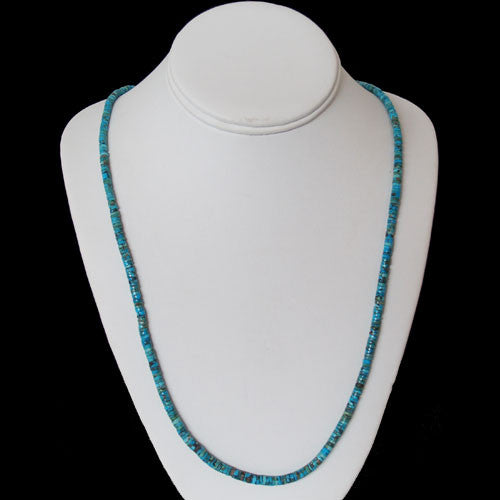
Santo Domingo Tiny Handmade Gem Grade Villa Grove Turquoise Bead Necklace - Ray Lovato (#134)
$6,250.00
Artist: Ray Lovato
Total length: 32 1/2"
High grade, natural Villa Grove turquoise is one of the most rare and sought after turquoise on the market today. George Musik mined the turquoise in this Ray Lovato necklace; sometime in the span of time he owned and operated the mine. When Randy Christenson purchased the Villa Grove mine, from George, he acquired the rough turquoise as well. We bought the stone from Randy and passed it on to Santa Domingo lapidary artist Ray Lovato, who cut these magnificent beads. If that is not a joyful trail of events we do not know what is.
Villa Grove Turquoise
The Villa Grove Turquoise Mine, aka; The Hall Mine, is located seven miles northwest of the town of Villa Grove, in the North end of the San Luis Valley of Colorado, at 10,000 feet in elevation. The Villa Grove turquoise mine showed signs of being worked by the Ancient Native American's. It was rediscovered sometime in the 1890’s and mined for copper with turquoise operations beginning in the early 1900’s. The Villa Grove mine was first mentioned in 1893. The largest dig site in the area is difficult to mine because it fills with water from a nearby spring. The mines largest production occurred during the 1930s through the 1950s when Bob Hall, Menalis Winfield, George Musik and others owned it. Randy Christenson purchased the Mine from George Musik in 2000. Randy is producing small amounts of Villa Grove turquoise at this time.
About the artist:

The gift of humor is a blessing to those who have it, and to those of us exposed to the comic. From an early age, Steve and I have been blessed with the humor of Santa Domingo artist Ray Lovato. Not only does Ray create exceptional jewelry, he does it with wit and comedy. He always has an aura of happiness around him, and this attitude seems to spread, like a California fog, to those who know him. In addition to his artistic talents, Ray is also a gifted salesman. When he pulls up in front of the trading post we know that there is a good possibility that we will soon be parting company with our available cash.
Related legends:
Precious Stones
Turquoise; Precious stones have symbolic implications. For example, turquoise if a "collective term for all the precious stones, wealth, or mixed offerings. Good fortune is attributed to this stone." Both white shell and turquoise are emphasized in Kinaalda? More about this legend
